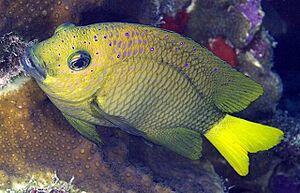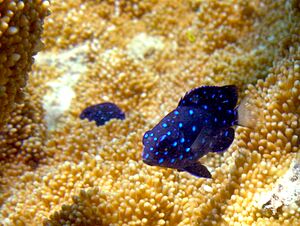Microspathodon chrysurus facts for kids
Quick facts for kids Microspathodon chrysurus |
|
|---|---|
 |
|
| Adult | |
 |
|
| Juveniles | |
| Conservation status | |
| Scientific classification | |
| Synonyms | |
|
The yellowtail damselfish (Microspathodon chrysurus) is a colorful fish found in warm, tropical waters. It lives mainly near coral reefs in places like the Caribbean Sea, off the coast of Panama. This fish is very common in its habitat. Experts say it is a species of "least concern," meaning it is not currently in danger of disappearing. People sometimes catch them for food or for aquariums. However, an invasive fish called the lionfish might be a threat to them.
It's interesting that young yellowtail damselfish look very different from adults. For a long time, people thought they were two separate kinds of fish! Adult damselfish are brown with a bright yellow tail fin. Young damselfish, on the other hand, are purple with blue spots on their back and clear tail fins.
Contents
Reproduction and Life Cycle
Yellowtail damselfish start their spawning cycle (when they lay eggs) around sunrise. This usually lasts for about an hour. Before this, the male damselfish gets a nest ready on dead coral. Their eggs are demersal, which means they stick to the bottom surface. The male fish then guards the eggs and keeps them healthy by fanning water over them.
The eggs hatch on the morning of the sixth day. These fish are most active in laying eggs during certain times of the moon cycle. This happens when the moon and sun's gravity are strongest, causing very high tides called spring tides.
What Do Yellowtail Damselfish Eat?
The eating habits of yellowtail damselfish change as they grow up. Young damselfish mostly eat tiny animals. Adult damselfish, however, mainly graze on algae. This means they are omnivorous, eating both plants and animals.
Scientists have studied what's inside their stomachs to learn about their diet. Young damselfish mostly eat tiny stinging cells called nematocysts (from jellyfish-like creatures) and tiny algae called zooxanthellae. As they become adults, they become pickier eaters. They prefer to eat blue-green algae, also known as cyanophytes. But if there's a lot of other food around, they will eat that too!
Sharing Space and Competing for Food
Yellowtail damselfish often share their feeding areas with two other types of damselfish: Stegastes dorsopunicans and Stegastes planifrons. All three kinds of fish eat the same tiny algae that grow on the seafloor. They also have similar feeding schedules.
When it comes to protecting their feeding spots, yellowtail damselfish are not as good as the other Stegastes species at keeping intruders away. However, yellowtail damselfish have a special advantage: their size! They are usually bigger than the other damselfish. They use their size to be aggressive towards the other fish, helping them get more food.
Gallery
-
Elkhorn coral with a Yellowtail Damselfish in the Caribbean Sea in Curaçao







